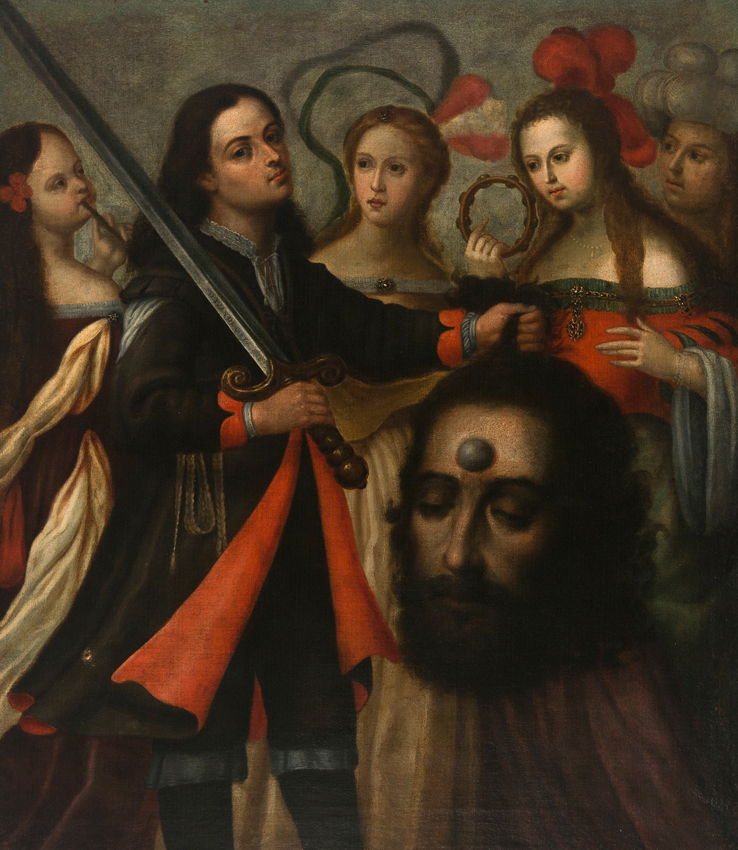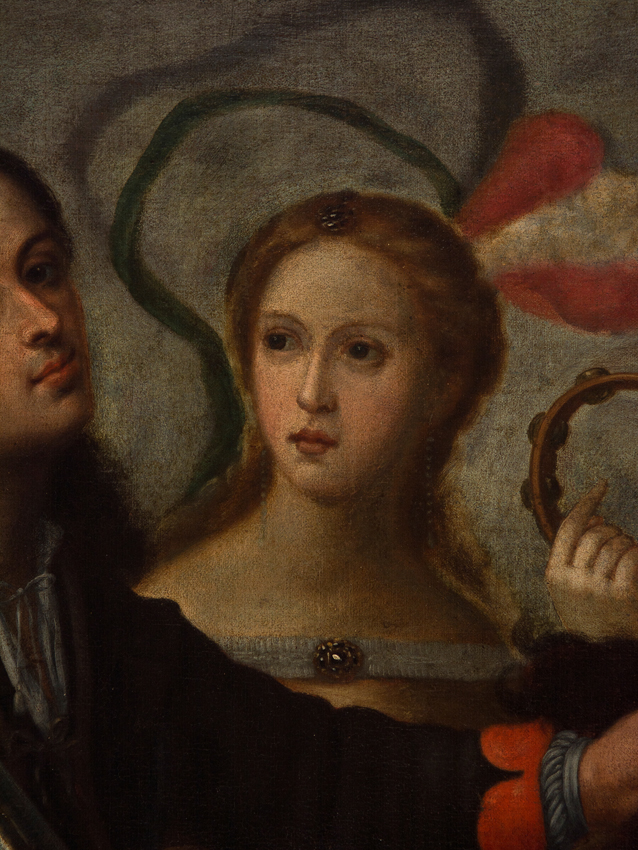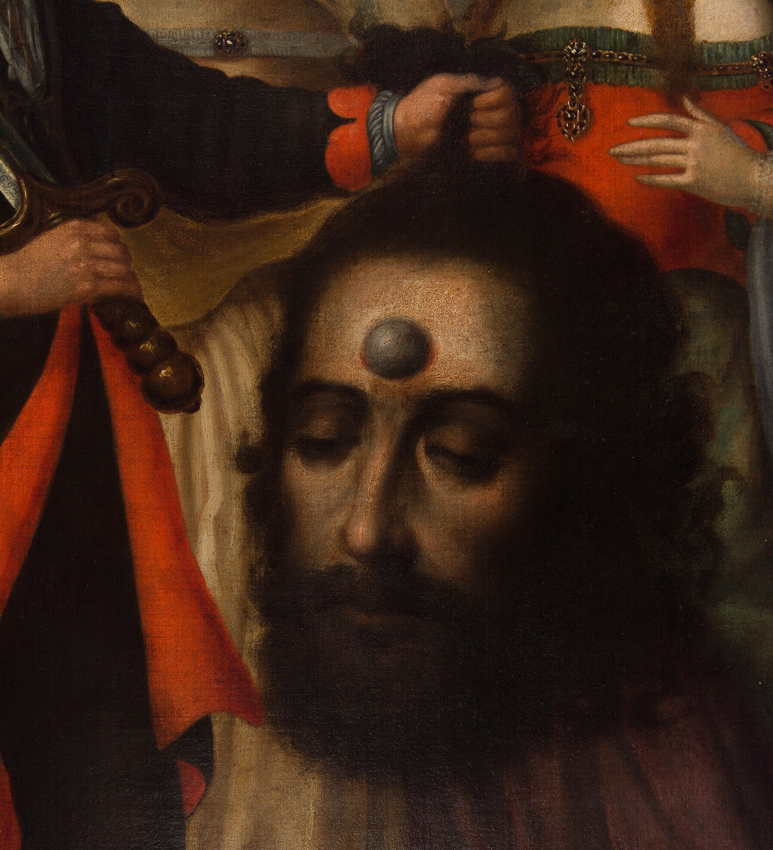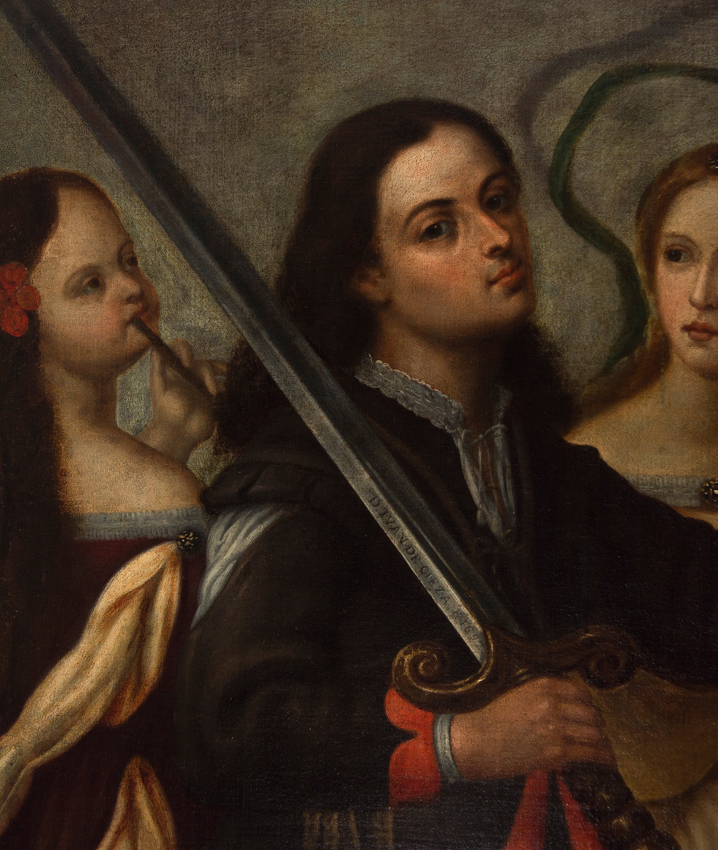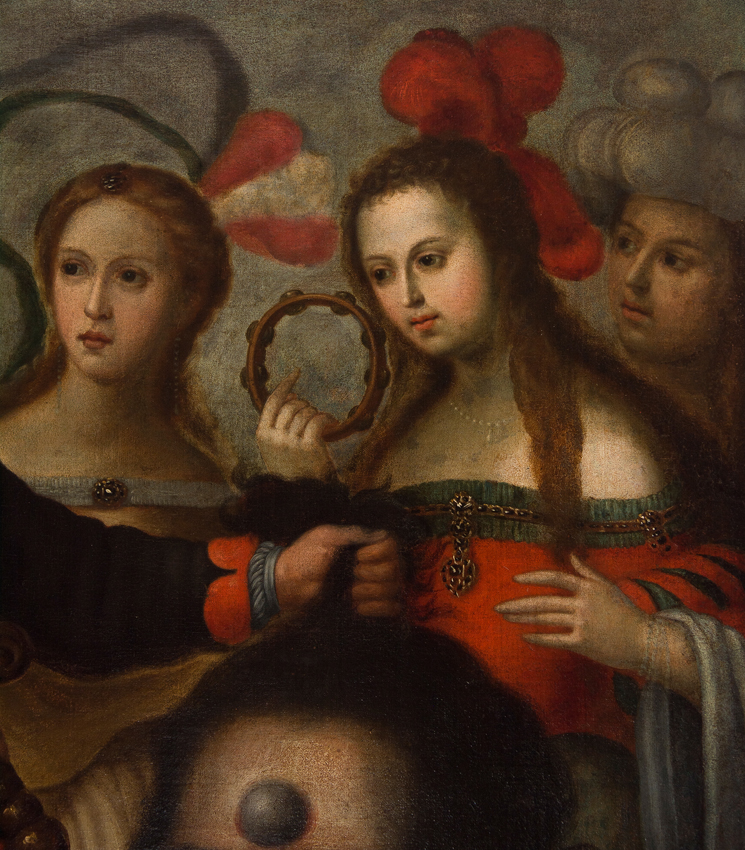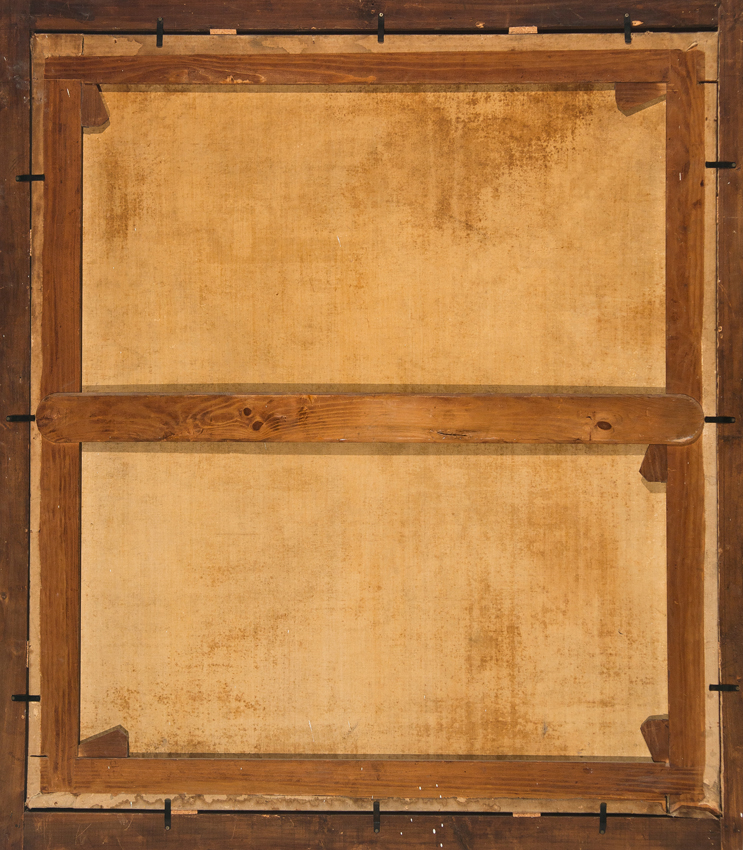15
Jose de Cieza Flores (Granada, 1656 - Madrid, 1692)
In Millésime 24
José de Cieza Flores (Granada, 1656 - Madrid, 1692)
"David defeats Goliath"
Oil on canvas. Signed and dated 1692 on the sword.
130 x 110 cm.
Dynamic and lively half-bust portrait of David with the head of the freshly decapitated Philistine Goliath, typical of the naturalism of 17th-century Baroque painting.
José de Cieza Flores, the artist, painted his signature and the year 1692 on the sword carried by the shepherd, amidst a chorus of ladies or "nymphs" of the time, who sing about the triumphant deed with musical instruments, rejoicing with the victor. This painting is of great importance amongst those of José de Cieza's, as it was created when he was already an honorary painter and artist to the King (from 1689), support he obtained through the influence of the constable of Castile, his protector during his stay in Madrid.
With clear Caravaggesque tones, he has painted a biblical scene, making the religious theme the centre of the composition. He has painted the act of "facing a gigantic challenge" with realism, just as we read in the Bible in 1 Samuel 17.
A simple Israelite shepherd is faced with a fierce and giant Philistine. Despite the fear of the Israelites, his faith in Jehovah prevails, and David puts his trust in God. The young Israelite is dressed in armour. It is not an anachronism: King Saul gave it to him, but as it was too big, David took it off and decided to fight without it, in his shepherd's clothes. With a simple sling and stones he triumphed against the giant, "without sword or armour," as the scriptures say. He holds the defeated giant's sword.
The weak becomes strong, with an impenetrable iron breastplate, and the strong and fierce giant falls collapsed with the precise blow of a simple stone to his forehead.
David, beardless and feminine, as described in the Bible, could almost come out of a Caravaggio portrait. There is also a similar cast of courtesans such as models and musicians in the painting "Concert of Youths" by the Italian painter, adorned with headdresses, rich dresses, and brocades typical of the painter's time, celebrating the triumph of their friend, the defeat of the oppressor, and above all, the greatness of Jehovah shown in the weak overcoming the strong.
Cieza was born in Granada in 1646. The son of the painter Miguel Jerónimo de Cieza, he trained in his father's workshop, following the pictorial guidelines of the school of Alonso Cano and growing up in the artistic atmosphere of the city. He continued his training with his father's most outstanding disciple and friend, Pedro Atanasio Bocanegra.
As we read in the account of José de Cieza from the Royal Academy of History:
After an initial period of collaboration in the family workshop, on religious works and some ephemeral decorations for the Corpus Christi festivities, he moved to Madrid (1685) after his father's death.
In the Court, he joined the group of artists responsible for theatrical decorations for the palace of Buen Retiro. His work earned him the title of honorary painter of the King (1689), which he achieved through the influence of the constable of Castile, apparently his protector in Madrid.
Some of his works include, for example, "The Infant Jesus with Two Angels," from 1673, belonging to the BSCH collection in Madrid; "Christ and the Samaritan Woman," from 1674, located in the hermitage of San Miguel in Granada; the Saint Johns of the Royal Chapel of Granada, the Apparition of Saint Francis of Paola, 1691, kept in the Prado Museum, as well as a painting of Saint Hierotheos and Saint Dionysius in the Episcopal Museum of Huesca.
Additionally, there is a drawing, "Saint Francis of Paola before the King of Naples," which is part of the collection at the British Museum in London.
This painting was part of the exhibition "Unpublished Works of the Granada Baroque," at the Cajagranada Foundation from January 2021 to April 2022.
Bibliographic reference:
- Aterido Fernández, Ángel. (n.d.). "José de Cieza Flores". https://dbe.rah.es/biografias/52199/jose-de-cieza-flores
José de Cieza Flores (Granada, 1656 - Madrid, 1692)
"David defeats Goliath"
Oil on canvas. Signed and dated 1692 on the sword.
130 x 110 cm.
Dynamic and lively half-bust portrait of David with the head of the freshly decapitated Philistine Goliath, typical of the naturalism of 17th-century Baroque painting.
José de Cieza Flores, the artist, painted his signature and the year 1692 on the sword carried by the shepherd, amidst a chorus of ladies or "nymphs" of the time, who sing about the triumphant deed with musical instruments, rejoicing with the victor. This painting is of great importance amongst those of José de Cieza's, as it was created when he was already an honorary painter and artist to the King (from 1689), support he obtained through the influence of the constable of Castile, his protector during his stay in Madrid.
With clear Caravaggesque tones, he has painted a biblical scene, making the religious theme the centre of the composition. He has painted the act of "facing a gigantic challenge" with realism, just as we read in the Bible in 1 Samuel 17.
A simple Israelite shepherd is faced with a fierce and giant Philistine. Despite the fear of the Israelites, his faith in Jehovah prevails, and David puts his trust in God. The young Israelite is dressed in armour. It is not an anachronism: King Saul gave it to him, but as it was too big, David took it off and decided to fight without it, in his shepherd's clothes. With a simple sling and stones he triumphed against the giant, "without sword or armour," as the scriptures say. He holds the defeated giant's sword.
The weak becomes strong, with an impenetrable iron breastplate, and the strong and fierce giant falls collapsed with the precise blow of a simple stone to his forehead.
David, beardless and feminine, as described in the Bible, could almost come out of a Caravaggio portrait. There is also a similar cast of courtesans such as models and musicians in the painting "Concert of Youths" by the Italian painter, adorned with headdresses, rich dresses, and brocades typical of the painter's time, celebrating the triumph of their friend, the defeat of the oppressor, and above all, the greatness of Jehovah shown in the weak overcoming the strong.
Cieza was born in Granada in 1646. The son of the painter Miguel Jerónimo de Cieza, he trained in his father's workshop, following the pictorial guidelines of the school of Alonso Cano and growing up in the artistic atmosphere of the city. He continued his training with his father's most outstanding disciple and friend, Pedro Atanasio Bocanegra.
As we read in the account of José de Cieza from the Royal Academy of History:
After an initial period of collaboration in the family workshop, on religious works and some ephemeral decorations for the Corpus Christi festivities, he moved to Madrid (1685) after his father's death.
In the Court, he joined the group of artists responsible for theatrical decorations for the palace of Buen Retiro. His work earned him the title of honorary painter of the King (1689), which he achieved through the influence of the constable of Castile, apparently his protector in Madrid.
Some of his works include, for example, "The Infant Jesus with Two Angels," from 1673, belonging to the BSCH collection in Madrid; "Christ and the Samaritan Woman," from 1674, located in the hermitage of San Miguel in Granada; the Saint Johns of the Royal Chapel of Granada, the Apparition of Saint Francis of Paola, 1691, kept in the Prado Museum, as well as a painting of Saint Hierotheos and Saint Dionysius in the Episcopal Museum of Huesca.
Additionally, there is a drawing, "Saint Francis of Paola before the King of Naples," which is part of the collection at the British Museum in London.
This painting was part of the exhibition "Unpublished Works of the Granada Baroque," at the Cajagranada Foundation from January 2021 to April 2022.
Bibliographic reference:
- Aterido Fernández, Ángel. (n.d.). "José de Cieza Flores". https://dbe.rah.es/biografias/52199/jose-de-cieza-flores
Millésime 24
Sale Date(s)
Venue Address
General delivery information available from the auctioneer
The purchase price includes the delivery of the lots in the venue of the auction. Transporting to other destinations is at the own risk of the client. The customer must contact "LST", to give the corresponding instructions for such transporting. "LST" is not responsible for the packaging or any accident incurred during transportation.
Important Information
Once again, we start the year with a special auction, called Millésime.
A catalog of 73 lots of European, Novo-Hispanic and Vicerregal art, so spanish americas art, where you will find paintings, furniture, decorative arts etc.
We hope you enjoy it!!
Terms & Conditions
CONDITIONS OF THE AUCTION:
I. REGISTRATION. To bid in the room customers must register at the beginning, filling out a form and picking a number that will identify them during the auction. Customers may be required to register in bank references or other guarantee system and if they do not prove the solvency "LST" will not accept bids and award the auction.
II. WRITTEN BIDS. "LST" will accept written bids, which will be formalized in the form provided by the room until the day before the auction. In such auctions, the room will bid in name of the client until the maximum stated in the offer and always at the lowest possible price. If there are two or more bids for the same amount, the one placed first will have the priority. Written bids received in advance, will have priority on the day of the auction.
III. TELEPHONE BIDS. "LST" will allow telephone bids, if interested people contact "LST" days before the auction providing personal data, ID card and the phone number which will be used by the staff of "LST" to call at the time of the auction. The buyer, within all the legal rights is making an offer for the asking price, when applies for telephone bid. "LST" will not take responsibility for any technical defects beyond its control, which may prevent to contact successfully the bidder during the auction.
IV. AUCTIONEER. The auction will be conducted by an auctioneer, director of the auction will be judge and arbitrator of it with full authority in its development, will award the lots to the highest bidder and is able to settle any controversy concerning lots sale, reject bids, divide lots or group them and remover objects from the room. Will be able to, if it is deemed suitable, not accept bids on the auction. His decision will be unappealable.
V. SALE OF LOTS. The lots are awarded to the highest bidder. Once the auctioneer blows the hammer, the buyer becomes responsible of the lot purchased, exempting "LST" of liability to for any damage and / or accidents that may occur. No refunds of lots.
VI. STARTING PRICE. The amount shown in the catalogue as the starting price for each lot will be, as a rule, the minimum selling price, except for exceptional cases where a reservation may be agreed upon with the seller or it set discretionary by the room.
VII. SCALE OF BIDS. The bids are set according to the following scale:
From 50.-€ to 200.-€…………………………………………..at 10.-€
From 200.-€ to 500.-€…………………………………… …25 in 25.-€
From 500.-€ to 1.000.-€………………………………..…..….50 in 50.-€
From 1.000.-€ to 2.000.-€………………………………..…100 in 100.-€
From 2.000.-€ to 5.000.-€……………………………….….250 in 250.-€
From 5.000.-€ to 10.000.-€…………………………………500 in 500.-€
From 10.000.-€ to 20.000.-€……………………………1.000 in 1.000.-€
From 20.000.-€ to 50.000.-€……………………………2.500 in 2.500.-€
From 50.000.-€ to 100.000.-€…………………………..5.000 in 5.000.-€
From 100.000.-€ to 100.000.-€………………………10.000 in 10.000.-€
From 200.000.-€ to 200.000.-€………………………25.000 in 25.000.-€
From 500.000.-€ to 500.000.-€………………………50.000 in 50.000.-€
VIII. RIGHT OF ADMISION. "LST" reserves the right to admission to the auction room and to reject, at its judgment, any purchase order, from clients whose solvency is not duly proved as well as not to sale auctions.
IX. SALE PRICES. The successful bidder of one or more lots must pay "LST" the final sale price achieves at auction, plus the 24,5 % plus 21% VAT on the commission.
X. CATALOG DATA. The catalogue data are obtained in order to careful research and advice, however, any responsibility is afforded about its accuracy. The lots will be auctioned in the state in which they are, not accepting any claims in restorations, breakage, damage, imperfections and, even description or numbering mistakes in the catalogue, in case of it, being the burden of the buyers to make sure before the auction that the description matches with their personal opinion about respective lot. The exhibition of the lots is intended to allow a perfect review and study of them.
XI. PAYMENT AND REMOVAL OF LOTS. Payment and removal of the lots will be held no later than five days following the auction. After this period expire without having the buyer removed the lot or lots purchases, it will accrue an expense of custody of 6 euros per day on each lot.
15 days after the auction without having the buyer paid and removes the sold lots, "LST" will inform the seller and there will begin judicial proceeding in order to obtain payment. The delay in payment by the purchaser of his/her sold lots will carry an interest increase at a rate of 1,5% per month.
XII. DELIVERY OF LOTS. The purchase price includes the delivery of the lots in the venue of the auction. Transporting to other destinations is at the own risk of the client. The customer must contact "LST", to give the corresponding instructions for such transporting. "LST" is not responsible for the packaging or any accident incurred during transportation.
XIII. RIGHT OF FIRT REFUSAL AND REPURCHASE. "LST" in order to article 38 of "Ley 16/1985 de 25 Junio del Patrimonio Histórico Español" (BOE. 155 June 29, 1985), will notify in advance to the Ministry of Culture, the content of their catalogues. Concerning the lots subject to the legislation referred to in the preceding paragraph, the Administration may exercise the rights of first refusal and repurchase according to the law. "LST" will watch over the protection of Artistic, Historical and Bibliographical Heritage of Spain. For customers out of European Community, a tax for export is required by the Administration.
XIV. VALUE ADDED TAX (I.V.A). This tax will be accrued on commissions of "LST" for buyers, using the rates prevailing on the date of the auction.
XV. DATA PROTECTION. In order to the "Ley 15/1999 de 13 de Diciembre, de Protección de Datos de Carácter Personal", the client authorize "LST", the inclusion of their data in a customer file, and for the promotion by "LST" of the objects at all times the rights of access, rectification or deletion of personal data by sending the appropriate request to the following address: LA SUITE SUBASTAS, C/ Conde Salvatierra, 8, 08006. Barcelona.
XVI. EXPRESS LEGAL JURISDICTION. These Conditions are governed by and interpreted in accordance with the rules of Spanish law. The mere act of participating in the auction as seller, buyer or bidder, implies acceptance of these Terms and Conditions.
Sales operations are understood to be held at the registered office of "LST", C/ Conde de Salvatierra, 8, 08006. Any dispute shall be taken to the competent courts of Barcelona, expressly waiving any other jurisdiction, in accordance with Article 55 of the "Ley de Enjuiciamiento Civil".
















